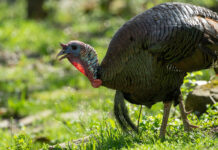Like most southern Illinois farms of my youth, my family had a closet filled with guns.
It was just inside the living room, and it held my father’s 12-gauge Marlin shotgun, his .22 caliber Remington pump rifle, brother Richard’s single-shot 20-gauge shotgun, brother David’s single-shot 410-shotgun and my single-shot .22 caliber rifle.
The same unlocked closet also held my mother’s ironing board, dust mop and “good” china.
Our boys’ single-shot arsenal had been Christmas presents when each of us reached 11 or 12 years old. In 1970, David inherited our grandfather’s 16-gauge double-barreled shotgun. It, too, went into the gun/ironing board closet.
All rarely saw the light of day. Once or twice every late summer, my father would take us three oldest boys squirrel hunting. In the late fall we’d rabbit hunt — mostly from the combine and mostly with my .22. We never hunted geese, ducks, quail or deer.
Our limited interest in hunting, however, didn’t stop me from wanting more guns. Soon after I began driving the farm pick-up, I traded my homemade go-kart to hired man Jackie for his spotless Remington 12-gauge pump shotgun.
Soon it too went into the gun closet and stayed for years. In fact, I can’t recall ever hunting with it. After I went to college, older brother Richard borrowed it for a deer hunt and, I reckon, still has it.
That was a half century ago, and I never had a reason to ask him about it. Still don’t.
I did use my boyhood .22 to stalk groundhogs on a sandy ridge in a distant field by an old slough. The easy-digging sand wasn’t the only reason the groundhogs moved in. Every summer (“Twenty-first of July, wet or dry.”), Uncle Honey sowed a half-acre or so of turnips in the sand for easy harvesting throughout the fall.
A half acre of turnips sounds like a lot of turnips until you factor in the bushels a small herd of piggish groundhogs — who were so fat they resembled rolling waves of brown fur when they ran — will eat before you ever get one for your soup pot.
I did reclaim my rifle after college but, after decades of little use, I gave it to my youngest brother years ago.
Sometime in the 1980s, my father inherited two pistols. The first was an 1840s pin-fired revolver some uncle had acquired in an unknown manner. Dad thought it a museum piece and displayed it on the family room’s wall for decades. I don’t know where it is today.
The other revolver was a chrome-plated .38 caliber Smith & Wesson “Police Special” with a buttery-soft leather holster. Dad said his Uncle Ches had kept it in the top drawer of his St. Louis’ work desk “just in case there was trouble.”
Dad never explained what trouble Uncle Ches might encounter selling linoleum.
The gun caused its own trouble later, however, when my father handed it to me one Christmas. It wasn’t a gift; he just wanted to be rid of it. I took it and did what most reluctant new owners of a flashy, unregistered .38 might do: I buried it in the dark recess of my sock drawer for 30 years.
Finally, in 2019, I foisted it on a gun-collecting friend and, for the first time in almost six decades, I became a non-gun owning rural American. It wasn’t a plan; it was just a fact.
Much like today’s ever-present gun violence is just a fact, and the easy access to too many cheap, deadly weapons designed and manufactured only to harm people is a fact.
And here’s another fact: Clearly, this is America today and this is what America will continue to be until we get the courage and compassion to admit it and change it.
(The Farm and Food File is published weekly through the U.S. and Canada. Source material, past columns and contact information are posted at farmandfoodfile.com © 2024 ag comm)














